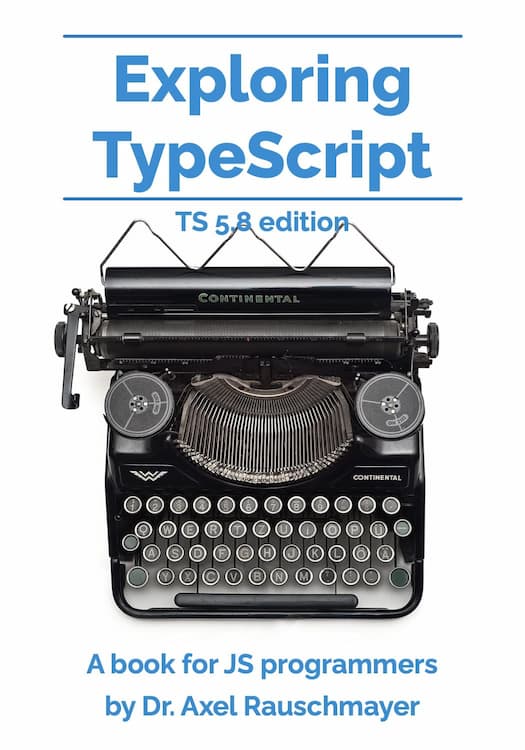Mapped types in TypeScript
A mapped type is a loop over keys that produces an object or tuple type and looks as follows:
{[PropKey in PropKeyUnion]: PropValue}
In this blog post, we examine how mapped types work and see examples of using them. Their most importing use cases are transforming objects and mapping tuples.
Notation used in this blog post
For showing computed and inferred types in source code, I use the npm package asserttt – e.g.:
// Types of values
assertType<string>('abc');
assertType<number>(123);
// Equality of types
type Pair<T> = [T, T];
type _ = Assert<Equal<
Pair<string>, [string,string]
>>;
What is a mapped type?
A mapped type lets us create an object by looping over a union of property keys:
type Obj = {
[PropKey in 'a' | 'b' | 'c']: number
};
type _ = Assert<Equal<
Obj,
{
a: number,
b: number,
c: number,
}
>>;
The union of property keys at the right-hand side of in determines how many loop iterations there are. In each iteration, PropKey refers to one of the elements of the union and a property is created:
-
The property key is
PropKey– by default. We’ll learn later how to override this default or completely prevent the creation of a property. -
The property value is specified by the right-hand side of the colon (
:).
Most common use case: transforming existing object types
The most common use case for a mapped type is transforming an existing object type. Then the property keys come from the object type:
type InputObj = {
str: string,
num: number,
};
type OutputObj = {
[K in keyof InputObj]: Array<InputObj[K]>
};
type _1 = Assert<Equal<
OutputObj,
{
str: Array<string>,
num: Array<number>,
}
>>;
We can also perform that change via a generic type:
type Arrayify<Obj> = {
[K in keyof Obj]: Array<Obj[K]>
};
type OutputObj2 = Arrayify<InputObj>;
type _2 = Assert<Equal<
OutputObj2, OutputObj
>>;
Mapping preserves the kind of type (tuple, array, object, etc.)
The input of a mapped type (tuple, array, object, etc.) determines what the output looks like:
type WrapValues<T> = {
[Key in keyof T]: Promise<T[Key]>
};
type _ = [
// Read-only tuple in, read-only tuple out
Assert<Equal<
WrapValues<readonly ['a', 'b']>,
readonly [Promise<'a'>, Promise<'b'>]
>>,
// Tuple labels are preserved
Assert<Equal<
WrapValues<[labelA: 'a', labelB: 'b']>,
[labelA: Promise<'a'>, labelB: Promise<'b'>]
>>,
// Array in, Array out
Assert<Equal<
WrapValues<Array<string>>,
Array<Promise<string>>
>>,
// ReadonlyArray in, ReadonlyArray out
Assert<Equal<
WrapValues<ReadonlyArray<string>>,
ReadonlyArray<Promise<string>>
>>,
// Object in, object out
Assert<Equal<
WrapValues<{ a: 1, b: 2 }>,
{ a: Promise<1>, b: Promise<2> }
>>,
// Read-only properties are preserved
Assert<Equal<
WrapValues<{ readonly a: 1, readonly b: 2 }>,
{ readonly a: Promise<1>, readonly b: Promise<2> }
>>,
];
If we use key remapping via as then a mapped type does not preserve its input type:
type KeyAsKeyToKey<T> = {
[K in keyof T as K]: K
};
type _ = Assert<Equal<
// Use Pick<> because result of KeyAsKeyToKey<> is large
Pick<
KeyAsKeyToKey<['a', 'b']>,
'0' | '1' | 'length' | 'push' | 'join'
>,
{ // An object, not a tuple!
length: 'length';
push: 'push';
join: 'join';
0: '0';
1: '1';
}
>>;
This result shows the real keyof result for tuples. Without as, mapped types filter that result before looping over a tuple. This special mode is explained in more detail in the blog post “Computing with tuple types in TypeScript”.
Changing property values via mapped types
In this section, we look at more examples of property keys of existing object types being transformed.
Example: making an interface asynchronous
The generic type Asyncify<Intf> converts the synchronous interface Intf into an asynchronous interface:
interface SyncService {
factorize(num: number): Array<number>;
createDigest(text: string): string;
}
type AsyncService = Asyncify<SyncService>;
type _ = Assert<Equal<
AsyncService,
{
factorize: (num: number) => Promise<Array<number>>,
createDigest: (text: string) => Promise<string>,
}
>>;
This is the definition of Asyncify:
type Asyncify<Intf> = {
[K in keyof Intf]: // (A)
Intf[K] extends (...args: infer A) => infer R // (B)
? (...args: A) => Promise<R> // (C)
: Intf[K] // (D)
};
- We use a mapped type to iterate over the properties of
Intf(line A). - Per property
Kwe check if the property valueIntf[K]is a function or method (line B).- If yes then we use the
inferoperator to extract the arguments into the type variableAand the return type into the type variableR. We use those variables to create a new property value where the return typeRis wrapped in a Promise (line C). - If no, then the property value not changed (line D).
- If yes then we use the
Example: adding keys to an enum of objects
Consider the following enum of objects:
const tokenDefs = {
number: {
key: 'number',
re: /[0-9]+/,
description: 'integer number',
},
identifier: {
key: 'identifier',
re: /[a-z]+/,
},
} as const;
We’d like to avoid having to redundantly mention .key. Let’s use a helper function addKey() for that purpose:
// Information we have to provide
interface InputTokenDef {
re: RegExp,
description?: string,
}
// Information addkeys() adds for us
interface TokenDef extends InputTokenDef {
key: string,
}
const tokenDefs = addKeys({
number: {
re: /[0-9]+/,
description: 'integer number',
},
identifier: {
re: /[a-z]+/,
},
} as const);
It’s very useful that addKeys() does not lose type information: The computed type of tokenDefs correctly records where property .description exists and where it doesn’t:
assertType<
{
readonly number: {
readonly re: RegExp,
readonly description: 'integer number',
key: string,
},
readonly identifier: {
readonly re: RegExp,
key: string,
},
}
>(tokenDefs);
That means TypeScript lets us use tokenDefs.number.description (which exists) but not tokenDefs.identifier.description (which does not exist).
This is what addKeys() looks like:
function addKeys<
T extends Record<string, InputTokenDef>
>(tokenDefs: T)
: {[K in keyof T]: T[K] & {key: string}} // (A)
{
const entries = Object.entries(tokenDefs);
const pairs = entries.map(
([key, def]) => [key, {key, ...def}]
);
return Object.fromEntries(pairs);
}
In line A, we use & to create an intersection type that has both the properties of T[K] and {key: string}.
Changing property keys via key remapping (as)
In the key part of a mapped type we can use as to change the property key of the current property:
{ [P in K as N]: X }
In the following example, we use as to add an underscore before each property name:
type Point = {
x: number,
y: number,
};
type PrefixUnderscore<Obj> = {
[K in keyof Obj & string as `_${K}`]: Obj[K] // (A)
};
type X = PrefixUnderscore<Point>;
type _ = Assert<Equal<
PrefixUnderscore<Point>,
{
_x: number,
_y: number,
}
>>;
In line A, the template literal type _${K} does not work if K is a symbol. That’s why we intersect keyof Obj with string and only loop over the keys of Obj that are strings.
Filtering properties
So far, we have only changed property keys or values of object types. In this section, we look at filtering out properties.
Filtering properties via key remapping (as)
The easiest way to filter is via as: If we use never as a property key then the property is omitted from the result.
In the following example, we remove all properties whose values are not strings:
type KeepStrProps<Obj> = {
[
Key in keyof Obj
as Obj[Key] extends string ? Key : never
]: Obj[Key]
};
type Obj = {
strPropA: 'A',
strPropB: 'B',
numProp1: 1,
numProp2: 2,
};
type _ = Assert<Equal<
KeepStrProps<Obj>,
{
strPropA: 'A',
strPropB: 'B',
}
>>;
Filtering properties by filtering key unions
Before TypeScript has key remapping via via as, we had to filter the union with property keys before iterating over it with a mapped type.
Let’s redo the previous example without as: We want to filter out properties of the following type Obj whose values are not strings.
type Obj = {
strPropA: 'A',
strPropB: 'B',
numProp1: 1,
numProp2: 2,
};
The following generic helper type collects the keys of all properties whose values are strings:
type KeysOfStrProps<T> = {
[K in keyof T]: T[K] extends string ? K : never // (A)
}[keyof T]; // (B)
type _1 = Assert<Equal<
KeysOfStrProps<Obj>,
'strPropA' | 'strPropB'
>>;
We compute the result in two steps:
- Line A: First, we create an object where each property key
Kis mapped to:K– if the property valueT[K]is a stringnever– otherwise
- Line B: Then we extract all property values of the object we just created.
With KeysOfStrProps, it’s now easy to implement KeepStrProps without as:
type KeepStrProps<Obj> = {
[Key in KeysOfStrProps<Obj>]: Obj[Key]
};
type _2 = Assert<Equal<
KeepStrProps<Obj>,
{
strPropA: 'A',
strPropB: 'B',
}
>>;
Built-in utility type for keeping properties: Pick<T, KeysToKeep>
The following built-in utility type lets us create a new object by specifying which properties of an existing object type we want to keep:
/**
* From T, pick a set of properties whose keys are in the union K
*/
type Pick<T, K extends keyof T> = {
[P in K]: T[P];
};
We keep a subset of the properties of T by iterating over a subset K of its property keys (keyof T).
Pick is used as follows:
type ObjectLiteralType = {
eeny: 1,
meeny: 2,
miny: 3,
moe: 4,
};
// %inferred-type: { eeny: 1; miny: 3; }
type Result = Pick<ObjectLiteralType, 'eeny' | 'miny'>;
Built-in utility type for filtering out properties: Omit<T, KeysToFilterOut>
The following built-in utility type lets us create a new object type by specifying which properties of an existing object type we want to omit:
/**
* Construct a type with the properties of T except for those in
* type K.
*/
type Omit<T, K extends keyof any> = Pick<T, Exclude<keyof T, K>>;
Explanations:
-
K extends keyof anymeansKmust be a subset of all possible property keys:type _ = Assert<Equal< keyof any, string | number | symbol >>; -
Exclude<keyof T, K>>means: take the keys ofTand remove all “values” mentioned inK.
Omit<> is used as follows:
type ObjectLiteralType = {
eeny: 1,
meeny: 2,
miny: 3,
moe: 4,
};
type _ = Assert<Equal<
Omit<ObjectLiteralType, 'eeny' | 'miny'>,
{ meeny: 2; moe: 4; }
>>;
Adding and removing modifiers via mapped types
In TypeScript, properties can have to kinds of modifiers:
- A property can be optional: modifier
? - A property can be read-only: modifier
readonly
We can add or remove these modifiers via mapped types.
Example: adding the optional modifier (?)
type AddOptional<T> = {
[K in keyof T]+?: T[K]
};
type RequiredArticle = {
title: string,
tags: Array<string>,
score: number,
};
type OptionalArticle = AddOptional<RequiredArticle>;
type _ = Assert<Equal<
OptionalArticle,
{
title?: string | undefined;
tags?: Array<string> | undefined;
score?: number | undefined;
}
>>;
The notation +? means: make the current property optional. We can omit the + but I find it easier to understand what’s going on if it’s there.
The built-in utility type Partial<T> is equivalent to our generic type AddOptional above.
Example: removing the optional modifier (?)
type RemoveOptional<T> = {
[K in keyof T]-?: T[K]
};
type OptionalArticle = {
title?: string,
tags?: Array<string>,
score: number,
};
type RequiredArticle = RemoveOptional<OptionalArticle>;
type _ = Assert<Equal<
RequiredArticle,
{
title: string,
tags: Array<string>,
score: number,
}
>>;
The notation -? means: make the current property required (non-optional).
The built-in utility type Required<T> is equivalent to our generic type RemoveOptional above.
Example: adding the readonly modifier
type AddReadonly<Obj> = {
+readonly [K in keyof Obj]: Obj[K]
};
type MutableArticle = {
title: string,
tags: Array<string>,
score: number,
};
type ImmutableArticle = AddReadonly<MutableArticle>;
type _ = Assert<Equal<
ImmutableArticle,
{
readonly title: string,
readonly tags: Array<string>,
readonly score: number,
}
>>;
The notation +readonly means: make the current property read-only. We can omit the + but I find it easier to understand what’s going on if it’s there.
The built-in utility type Readonly<T> is equivalent to our generic type AddReadonly above.
Example: removing the readonly modifier
type RemoveReadonly<Obj> = {
-readonly [K in keyof Obj]: Obj[K]
};
type ImmutableArticle = {
readonly title: string,
readonly tags: Array<string>,
score: number,
};
type MutableArticle = RemoveReadonly<ImmutableArticle>;
type _ = Assert<Equal<
MutableArticle,
{
title: string,
tags: Array<string>,
score: number,
}
>>;
The notation -readonly means: make the current property mutable (non-read-only).
There is no built-in utility type that removes readonly modifiers.
Detecting the property modifiers readonly and ? (optional)
Detecting if a property is read-only
This is what using a utility type IsReadonly would look like:
interface Car {
readonly year: number,
get maker(): string, // technically `readonly`
owner: string,
}
type _1 = [
Assert<Equal<
IsReadonly<Car, 'year'>, true
>>,
Assert<Equal<
IsReadonly<Car, 'maker'>, true
>>,
Assert<Equal<
IsReadonly<Car, 'owner'>, false
>>,
];
Alas, implementing IsReadonly is complicated: readonly currently does not affect assignability and cannot be detected via extends:
type SimpleEqual<T1, T2> =
[T1] extends [T2]
? [T2] extends [T1] ? true : false
: false
;
type _2 = Assert<Equal<
SimpleEqual<
{readonly year: number},
{year: number}
>,
true
>>;
The brackets around T1 and T2 are needed to prevent distributivity.
That’s why we need a stricter equality check:
type StrictEqual<X, Y> =
(<T>() => T extends X ? 1 : 2) extends
(<T>() => T extends Y ? 1 : 2) ? true : false
;
type _3 = [
Assert<Equal<
StrictEqual<
{readonly year: number},
{year: number}
>,
false
>>,
Assert<Equal<
StrictEqual<
{year: number},
{year: number}
>,
true
>>,
Assert<Equal<
StrictEqual<
{readonly year: number},
{readonly year: number}
>,
true
>>,
];
The helper type StrictEqual is a hack but currently the best technique for strictly comparing types. How it works is explained in the blog post “Testing types in TypeScript”.
Now we can implement IsReadonly (based on code by GitHub user inad9300):
type IsReadonly<T extends Record<any, any>, K extends keyof T> =
Not<StrictEqual<
{[_ in K]: T[K]}, // (A)
{-readonly [_ in K]: T[K]} // (B)
>>
;
type Not<B extends boolean> = [B] extends [true] ? false : true;
We compare two objects:
- One is created via normal mapping over the keys
KofT(line A). - The other one via mapping that removes the modifier
readonly(line B).
Related GitHub issue: “Allow identifying readonly properties in mapped types”
Detecting if a property is optional
This is what it looks like to use a helper type IsOptional that detects if a property is optional:
interface Person {
name: undefined | string;
age?: number;
}
type _1 = [
Assert<Equal<
IsOptional<Person, 'name'>, false
>>,
Assert<Equal<
IsOptional<Person, 'age'>, true
>>,
];
IsOptional is easier to implement than IsReadonly because optional properties are easier to detect:
type IsOptional<T extends Record<any, any>, K extends keyof T> =
{} extends Pick<T, K> ? true : false
;
How does that work? Let’s look at the results produced by Pick:
type _2 = [
Assert<Equal<
Pick<Person, 'name'>,
{ name: undefined | string }
>>,
Assert<Equal<
Pick<Person, 'age'>,
{ age?: number | undefined }
>>,
];
Only the latter object is assignable to the empty object {}.
Records are mapped types
The built-in utility type Record is simply an alias for a mapped type:
/**
* Construct a type with a set of properties K of type T
*/
type Record<K extends keyof any, T> = {
[P in K]: T;
};
Once again, keyof any means “valid property key”:
type _ = Assert<Equal<
keyof any,
string | number | symbol
>>;
Source of this blog post
- Chapter “Mapped Types” in the official TypeScript handbook.





